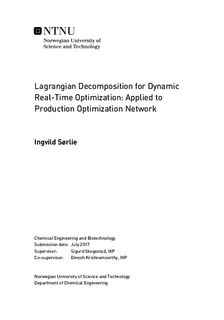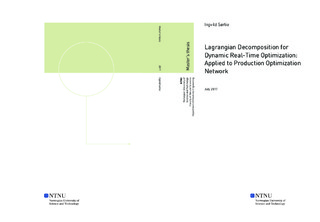| dc.description.abstract | The scope of this thesis was to investigate the use of lagrangian decomposition for a dynamic real-time optimization(RTO) problem. The decomposition was performed on a gas lifted two-well network, controlled by a nonlinear model predictive controller(NMPC). Even though decomposition is a well known and utilized method, it has not been investigated much for the upstream production of oil and gas. The dynamic lagrangian dual decomposition in this thesis is an extension of previous work with steady state decomposition for gas lifted well networks.
The lagrangian dual decomposed NMPC was modeled and simulated in Matlab using CasADi
v3.1.0, the NLP problem was solved with the IPOPT solver. The base case refers to the lagrangian decomposition simulations, which were performed for two different constraints becoming active. The simulation results were compared to a centralized NMPC and a steady state optimization for the same system. A successful decomposed NMPC should yield the same converged simulation values as the centralized NMPC and steady state optimization. Numerical methods were applied to improve the base case decomposed NMPC. The line search method, adjusting the step length α for each update of the lagrangian multiplier λ, was included to reach a better convergence of λ and lower the number of iterations needed. The augmented lagrangian, penalizing constraint violations, was included to improve the start-up dynamics of the base case decomposed NMPC.
The base case decomposition simulation results show that the decomposed NMPC converges to
the same results as the centralized NMPC and a steady state optimization performed for the same system. However, in certain cases, the dynamics in the initial part of the simulation could be problematic. For the case where the gas rate capacity is the active constraint, the decomposed simulation oscillates around the trajectory of the centralized NMPC, even violating the constraint. When the available gas lift is the active constraint, the start-up dynamics is not a problem. The line search method successfully brings down the number of iterations, but at the cost of a larger constraint violation than in the base case decomposition. The augmented lagrangian decomposition decreases the constraint violations and converges faster than the base case decomposition. Combined with the fact that λ converges and that the simulation needs few iterations, it makes this the best method for dynamic decomposition of this system.
Since the system used in this problem is very simple, the results are only of academic interest. No conclusion can be made on the realistic uses of dynamic decomposition for control within the oil and gas industry. However, the results show a possibility for this type of control system to be suitable for use in more complex systems. | |

